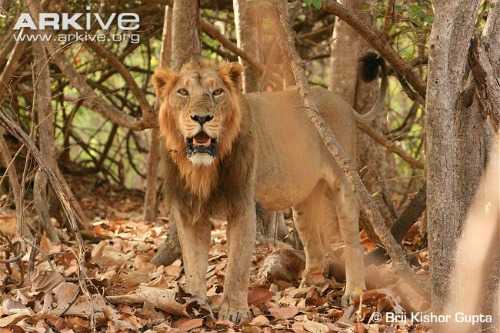The range of the Asiatic or Gir lion Panthera leo persica formerly stretched across the coastal forests of northern Africa and from northern Greece across south-west Asia to eastern India. The advent of firearms in the region led to their extinction over large areas. By the late 19th century, lions had been eradicated from Turkey. One of the last sightings of a lion in Iran was in 1941.
In India, lions once ranged over most of the continent, but severe hunting by Indian royalty and colonial powers led to a steady and marked decline in their numbers. By the turn of the 19th century, they were confined to the Gir Forest and protected by the Nawab of Junagadh in his private hunting grounds.
The current population of these big cats now consists of one isolated population in the Gir Forest Preserve of Gujurat in northwestern India. The wild population of Asiatic lions derived from just a dozen individuals that survived in the early 20th century. Their population was estimated to be 523 animals in 2015, up from 411 animals in 2010.
Physically very similar to their African cousins, Gir Lions are 10-20% smaller, have a larger tail tuft and usually have a distinct belly fold. Males also have somewhat smaller manes. Adult males weigh 160 to 190 kg (350 to 420 lbs), while females weigh 110 to 120 kg (240 to 260 lbs)
The Asiatic lion currently exists as a single subpopulation, and is thus vulnerable to extinction from disease epidemic or a large forest fire. There are indications of poaching incidents in recent years, and reports that organised gangs have switched attention from tigers to these lions.
Farmers on the periphery of the Gir Forest frequently use crude and illegal electrical fences by powering them with high voltage overhead power lines. These are usually intended to protect their crops from foraging ungulates but lions and other wildlife are also killed. Nearly 20,000 open wells dug by farmers in the area for irrigation have also acted as traps, which led to many lions drowning.
Prior to the resettlement of nomadic tribal herdsmen from the reserve, the Gir forest was heavily degraded and used by livestock, which restricted the population of native prey species. Various studies have shown tremendous habitat recovery and increases in wild ungulate populations during the last four decades.
Even though their habitat is a preserve, farmers still graze their cattle and goats within the boundaries, and people also regularly enter the park to gather firewood for cooking. Domestic cattle have historically been part of the Asian Lion’s diet but the most common prey species is the chital deer.
Establishment of at least one other wild population is advisable for population safety, maximizing genetic diversity, and in terms of ecology (re-establishing the lion as a component of the fauna in its former range). However, there are problems in attempting this: a previous attempt to establish a second sub-population in the Chandraprabha Wildlife Sanctuary in eastern Uttar Pradesh appeared to be succeeding, as the population grew from three to 11 animals, but then the lions disappeared, presumably shot or poisoned.
Palpur-Kuno Wildlife Sanctuary in northern Madhya Pradesh has now been selected as the best candidate area. Communities will require resettlement to make room for the Lions, but this time great care is being taken to make the process participatory and attempting to satisfy local needs, and not engender hostility toward Lion conservation.
Compare these cats to the more well-known African Lion.
Updated 2013


2 Responses